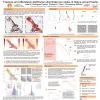Poster #090, Earthquake Forecasting and Predictability (EFP)
Statistical Analysis of Paleoseismically Determined Earthquake Recurrence
Poster Image:

Poster Presentation
2020 SCEC Annual Meeting, Poster #090, SCEC Contribution #10496 VIEW PDF
el each distribution using Normal, Exponential, Brownian passage-time (Matthew et al., 2002), and Weibull distributions. We find that the normal distribution poorly fits earthquake recurrence, as expected from the lack of a central tendency. A minority of data sets are well fit by the exponential distribution, consistent with a Poisson process with uniform hazard over time and no memory of prior events. Most of the paleoseismic records, however, indicate an increase in hazard over time. We find that the Brownian passage-time model, formulated as perturbations added to steady tectonic loading, systematically underpredicts the young tail of earthquake recurrence at all but two sites. We find better fits to the majority of paleoseismic data sets using a Weibull distribution. The Weibull model may be envisioned as arising from an ensemble of many possible failure points (earthquake nucleation sites) along a given length of the fault, at each of which the hazard is growing over time. Once initiated, a rupture grows and propagates through the point of observation at a paleoseismic trench. Earthquake distributions vary widely along the length of the 1857 Fort Tejon earthquake rupture and suggest that interactions with the Garlock Fault and the San Jacinto Fault affect the time to failure on the San Andreas fault.
SHOW MORE
SHOW MORE

































